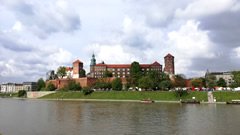2017 Japanese-Language Assistants’ Report: From Krakow, Poland
Manggha Museum of Japanese Art and Technology
IDE Gohei
What do you think of when you hear the word "Poland"? When the decision was made to dispatch me to Poland, I still remember opening a map to check the location of the country. Compared with Western Europe, about which Japanese people tend to have some idea of what it is like, Eastern Europe is probably an area about which they do not have much information.

The Manggha Museum of Japanese Art and Technology
However, Poland boasts the largest number of Japanese-language learners in Eastern Europe, with the latest survey reporting that there are more than 4,400 learners in the entire country. As for Japanese-language educational institutions, as well as universities with Japanese language departments, there are also many private Japanese-language schools that ordinary people pay to attend. The Manggha Museum of Japanese Art and Technology (Manggha Japanese Language School), where I am currently dispatched, is one of the private Japanese-language schools, although its parent organization is a national museum.
I am dispatched here mainly to be in charge of the daily Japanese-language classes and to support the management of Japanese-language courses for the entire school. At present, more than half of the students at the Manggha Japanese Language School are working adults, and a wide variety of classmates, from students to working adults, study together in the classroom. Another feature of the school is that, unusually for a private Japanese-language school overseas, it offers classes at all levels, from beginner classes starting from zero to advanced classes for the N1 and N2 levels of the Japanese-Language Proficiency Test (JLPT). I am currently in charge of different levels of classes: beginner, intermediate, and advanced. There are different things to be aware of at each level, and it has been a valuable experience for me as a teacher. Polish students are very talented and usually do an excellent job of preparing and reviewing, and they are very enthusiastic in class. With such students in front of me, I spend my days thinking about what I should do in the limited time I have in the classroom and how I can best contribute to improving the students' Japanese language skills.
One of my duties is to support the operation of Japanese-language courses at the school, so I have a lot of meetings with the local coordinators and teachers, and I also participate in steering the Japanese-language courses as a whole, such as deciding what teaching materials to use and how to design the courses.

Wawel Castle as seen from the classroom window
Another exciting part of working as a Japanese-Language Assistant is that I get to be involved in projects that promote Japanese-language education program throughout the country. It is a very stimulating and valuable experience to be able to play a role in events related to Japanese-language education throughout Poland, such as speech contests and teachers' network.
I still have more than a year to go in my term, but I hope to improve my abilities and be able to help more people in more places.
- What We Do Top
- Arts and Cultural Exchange [Culture]
- Japanese-Language Education Overseas [Language]
- Japanese-Language Education Overseas [Language] Top
- Learn Japanese-language
- Teach Japanese-language
- Take Japanese-Language Test
- Know about Japanese-language education abroad
- The Japanese-Language Institute, Urawa
- The Japanese-Language Institute, Kansai
- Japanese-Language Programs for Foreign Specified Skilled Worker Candidates
- Japanese Language Education for Japanese Children Resident Overseas and for the Descendants of Migrants
- Archives
- Japanese Studies and Global Partnerships [Dialogue]
- JF digital collection
- Other Programs / Programs to Commemorate Exchange Year
- Awards and Prizes
- Publications
